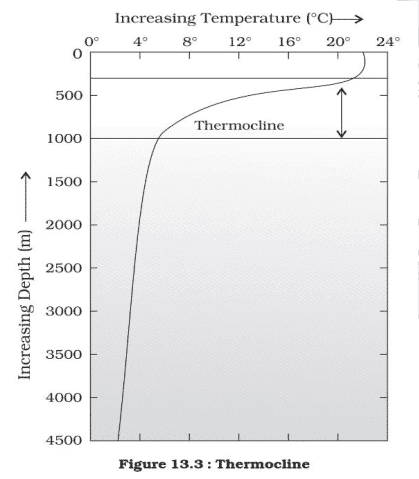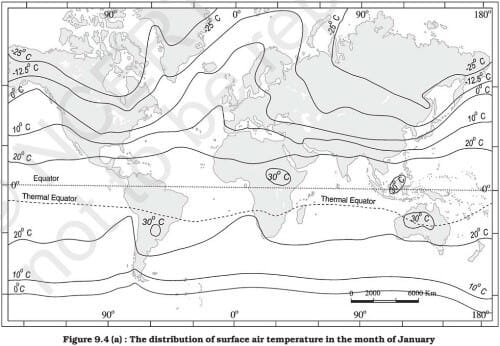- Oceans absorb more than 80 percent of the solar radiation that reaches the earth. Moreover, water has a remarkable capacity for absorbing heat.
- The uppermost 10 percent of the oceans contain more heat than the entire atmosphere.
- The temperature of the oceans is not uniform. It differs from latitude to latitude and from the surface to the bottom.
- The major determinants of ocean temperature are:
- Latitude: The surface temperature of the oceans declines from the equator towards the poles as the Sun’s rays are vertical on the equator and become slanting as one move towards the poles
- Prevailing Winds: Direction of the prevailing winds such as the Trade Winds, Westerlies etc., determines the surface temperature of ocean waters at a point. For instance, eastern edges of the ocean along the trade wind belt have cooler waters due to the pushing of the warm waters by the trade winds away from the coast causing the upwelling of bottom waters.
- Unequal distribution of Land and Water: The Northern Hemisphere has more land area than that of the Southern Hemisphere. Consequently, the oceans of the Northern are warmer than that of the Southern Oceans.
- Evaporation Rate: The volume of water that evaporates from the ocean surface is around 350,000 cubic kilometres per annum. However, the rate of evaporation is not uniform across different latitudes. Warmer tropical ocean waters have higher evaporation rate than the cooler temperate ocean waters.
- The density of water: The density of ocean water is mostly a function of its temperature and salinity. The density of waters also varies from latitude to latitude. In the areas of high salinity, the ocean waters are of a relatively higher temperature and vice versa.
- Ocean Currents: Surface temperature of oceans is also controlled by cold and warm currents. The presence of warm water increases the temperature and consequently the rate of evaporation. Consequently, the region records more rainfall, while the cold current reduces the temperature of the moisture-laden wind. The coast along which a cold water current flows records more fog, but less precipitation.
- Local Factors: Submarine ridges, local weather conditions like storms, cyclones, winds, fogs, cloudiness, the rate of evaporation, lapse rate, condensation, and precipitation also affect the distribution of temperature of the oceans.
- The study of the temperature of the oceans is important for determining the
- movement of large volumes of water (vertical and horizontal ocean currents),
- type and distribution of marine organisms at various depths of oceans,
- climate of coastal lands, etc.
- Source of Heat in Oceans
- The sun is the principal source of energy (Insolation).
- The ocean is also heated by the inner heat of the ocean itself (earth’s interior is hot. At the sea surface, the crust is only about 5 to 30 km thick). But this heat is negligible compared to that received from sun.
Vertical Distribution of Temperature:
- Both energy and sunlight decrease with depth in the oceans.
- Only about 45 percent of light energy striking the ocean surface reaches a depth of about one meter, and only 16 percent reaches a depth of 10 meters.
- On the basis of the temperature, the ocean depths may be divided into the following three zones:
- Surface Zone or Mixed Zone: This is also known as the Photic zone or Euphoric zone. It is the upper layer of the ocean. In this layer, the temperature and salinity are relatively constant. It contains about 2 percent of the total volume of water in the ocean. It is limited to a depth of about 100 meters.
- Thermocline: It lies between 100 metres and 1000 metres. It contains about 18 percent of the total volume of water in the ocean. There is a steep fall in temperature in this zone. The density of water increases with increasing depth.
- Deep Zone: This zone lies below 1000 metres in the mid-latitudes. This zone contains about 80 percent of the total volume of water in the ocean. The temperature in this zone remains constant. The ocean bottom always has a temperature which is one or two degrees Celsius above the freezing point.
Thermocline
- The profile shows a boundary region between the surface waters of the ocean and the deeper layers.
- The boundary usually begins around 100 – 400 m below the sea surface and extends several hundred of meters downward.
- This boundary region, from where there is a rapid decrease of temperature, is called the thermocline. About 90 per cent of the total volume of water is found below the thermocline in the deep ocean. In this zone, temperatures approach 0° C.

Horizontal Temperature Distribution of Oceans
- In general, the temperature of the surface water in the lower latitudes is about 26 degrees Celsius which decreases towards poles.
- The oceans of the Northern Hemisphere record an average temperature of 19.4 degrees Celsius. However, the average temperature recorded at various latitudes also varies with 22 degrees Celsius recorded at 20 degrees latitude, and 14 degrees Celsius recorded at 40 degrees latitude in the Northern Hemisphere.
- At the poles, the temperature drops to 0 degrees Celsius.
- The maximum and minimum annual temperatures of ocean water in the Northern Hemisphere are in the months of August and February respectively.
- The average annual range of temperature is about 12 degrees Celsius.
- The highest annual range of temperature is recorded in the North Atlantic Ocean. Moreover, the annual range of temperature is higher for the inland seas as compared to the open oceans.


Very informative
Useful website
Nice and informative